Updated WWI Memorial "Virtual Explorer" App publishing August 15, just in time for the New School Year The Doughboy Foundation is bringing the new National WWI Memorial from Washington, D.C. to schools, classrooms, dining rooms, dens, backyards, and driveways all over America with a new updated release of the award-winning Augmented Reality App called The WWI Memorial "Virtual Explorer" scheduled for release on August 15. 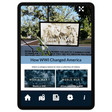 | | The "Virtual Explorer" app brings a walk-around-inside-it digital 3D model of the National WWI Memorial to students at home or in school classrooms using iOS or Android smartphones and tablets, available in many K-12 schools. | Students, teachers, or any interested party can access the National WWI Memorial themselves, wherever they are, rather than needing to go to Washington, D.C. to experience and explore it. More than that, the WWI Memorial "Virtual Explorer" App is filled with interactive and experiential WWI history. Click here to read all about the new and expanded WWI Memorial "Virtual Explorer" and learn how to download it to your phone or other mobile device on or after August 15. Honoring the Doughboys: Daily Taps at the National World War I Memorial 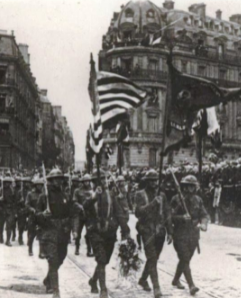 "It ought to be solemnized with pomp and parade, with shows, games, sports, guns, bells, bonfires, and illuminations, from one end of this continent to the other, from this time forward forever more," John Adams wrote to his wife, Abigail, on July 3, 1776. For 245 years the Fourth of July has been synonymous with hot dogs, red, white, and blue outfits purchased from Old Navy, and fireworks. Lots and lots of fireworks. Precisely as our Founding Father predicted. But in 1917, as war continued to rage on the Western Front, the newly arrived American Doughboys expected little pomp and circumstance to mark their nation's independence. However, leave it to the nation's oldest ally, the French, to throw a party. Click here to read more about how America's Independence Day was celebrated in Europe in 1917. | A Destiny of Undying Greatness:
Kiffin Rockwell and the Boys Who Remembered Lafayette  "Most Americans with a passing knowledge of history know of General Pershing's July 4, 1917, march through Paris with the newly arrived American troops to the tomb of Lafayette where, on behalf of America, Pershing's aide Colonel Charles Stanton uttered the famous words "Lafayette, we are here." But too many are unaware of the actions and sacrifices of Kiffin Rockwell and other American boys dating back to the outset of the Great War more than two and a half years before Pershing's arrival." Author Mark M. Trapp helps build more awareness of that pre-1917 service by Americans in WWI with his new book A Destiny of Undying Greatness: Kiffin Rockwell and the Boys Who Remembered Lafayette. Click here to read more about the book, and learn how a chance encounter with an unusual first name began five years of research that changed the author's life. | 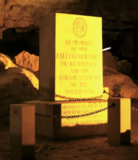 In the years between the first and second world wars, most people thought World War I really was the "War to End All Wars," and they reacted appropriately. Memorials were raised all over the country to men who died in the trenches "over there." At the time, there weren't really national memorials dedicated to those who died in America's wars, and those that were built weren't in Washington, D.C. After the unprecedented destruction and loss of life that came with World War I, municipalities across the United States began dedicating memorials to their local war dead. Click here to read more, and learn how the people of Barren County, Kentucky, through the local American Legion post, placed the tribute to their fallen loved ones inside of nearby Mammoth Cave. | 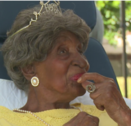 Elizabeth Francis was born in 1909. William Taft had just become President of the United States. The NAACP was in its infancy, only a few months old. At 7, Francis watched women fight for the right to vote. She lived through World War I and the Spanish Flu. She survived the Great Depression and lived through World War II. The March on Washington happened days after her 54th birthday. She saw the images from Vietnam and kept up with the space race. She's seen technology evolve and saw a monumental shift in civil rights for Americans. Click here to read more about Elizabeth, and see video of her drive-by 112th birthday celebration in Houston. |  A man is only missing if he is forgotten. Our Doughboy MIA this month is Corporal Juet Caudle. Not much has been discovered about our man this month, with further efforts hobbled by the continued closure of the National Personnel Records Center, which continues to try and catch up on their backlog of work due to Covid closure. What we do know is that Juet W. Caudle was born 14 October 1898 in Millville, Kentucky to George and Lida Caudle. He was the oldest of the five children the couple would have. They were a farming family, who owned their own land. Juet is occasionally listed as George J. Caudle and Jewet or Jewel Caudle. It appears that Caudle may have enlisted before the war (1915) while underage. What is known is that he was among the first of our troops that arrived overseas in June, 1917 with the 18th Infantry, 1st Division. Fighting all the way through the engagements the 18th Regiment was involved in during their first year in France, Caudle went into the Soissons Offensive with them on July 18th, 1918. Corporal Caudle is sometimes listed as having been killed in action on the first day of the offensive, while the ABMC officially lists his date of death as July 21st, 1918. Unfortunately nothing more is known about his case at his time. He is memorialized on the Tablets to the Missing at the Aisne-Marne American Cemetery at Belleau, France. Want to help us find out more about Caudle and the other 4,423 missing American service personnel from the war? Please consider making a donation to our 501(c)3 not for profit organization. Just visit www.ww1cc.org/mia today and make your tax deductible donation today. That way you'll have done your part to help us account for our missing boys too. Help us keep their memories alive. Can you spare just ten dollars? Give 'Ten For Them' to Doughboy MIA and help us make a full accounting of the 4,423 American service personnel still listed as missing in action from WW1. Make your tax deductible donation now, with our thanks. A man is only missing if he is forgotten. | Merchandise from the Official
Doughboy Foundation WWI Store 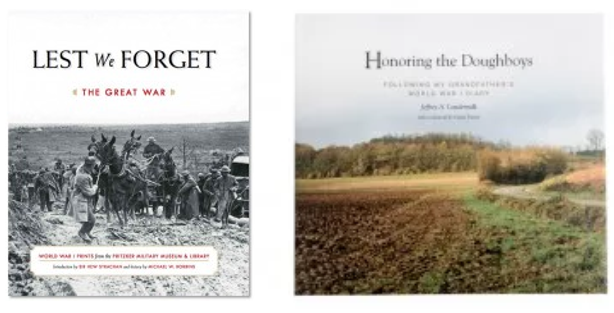 Lest We Forget: The Great War World War I Prints from the Pritzker Military Museum & Library. One of the nation's premier military history institutions pays tribute to the Americans who served and the allies they fought beside to defeat a resourceful enemy with a lavishly illustrated book. It is an official product of the United States World War One Centennial Commission and is a tribute to those who served in the Army, Navy, Marine Corps, and what would become the Air Force. It serves as a lasting reminder that our world ignores the history of World War I (and the ensuing WWII) at its peril―lest we forget. Honoring the Doughboys: Following My Grandfather's World War I Diary is a stunning presentation of contemporary photographs taken by the author that are paired with diary entries written by his grandfather, George A. Carlson, who was a soldier in the U.S. Army during World War I. Jeff Lowdermilk followed his grandfather's path through France, Belgium, Luxembourg, and Germany and returned with these meticulously crafted photographs and his own engaging stories that bring the diary to life for contemporary readers. Lowdermilk's passion for World War I and military history began as a young boy when he listened to his grandfather tell his stories about serving as an infantryman-- a "Doughboy"--in Europe during the Great War. Proceeds from the sale of these books will help build the new National World War I Memorial in Washington, DC. This and many other items are available as Official Merchandise of the Doughboy Foundation. |


No comments:
Post a Comment